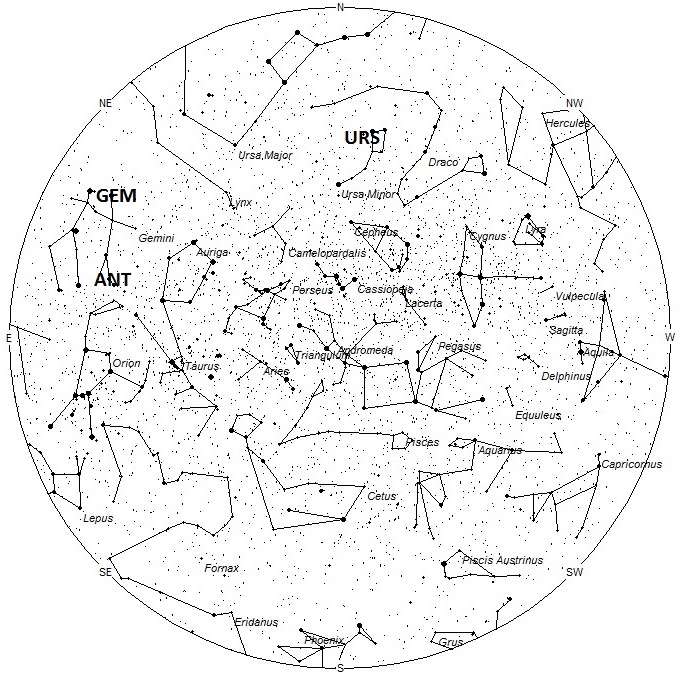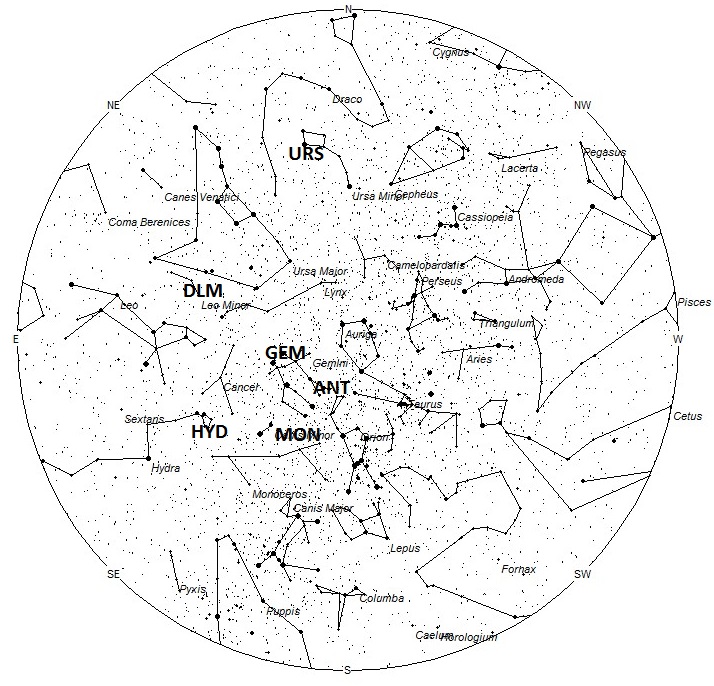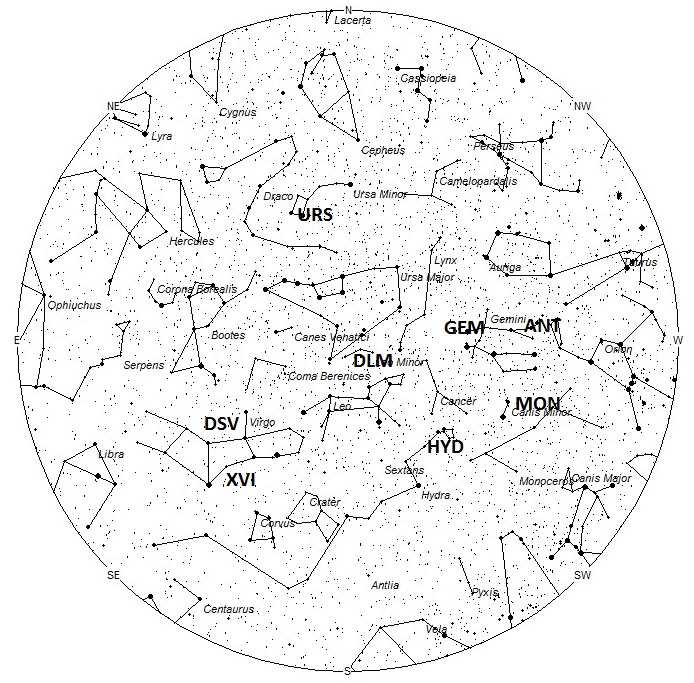During this period the moon reaches its full phase on Tuesday December 17th. At this time the moon will lie opposite the sun and will lie above the horizon all night long as seen from the northern hemisphere. This weekend the waxing gibbous moon will set shortly before dawn allowing a short window of opportunity to view meteor activity in dark skies. The estimated total hourly meteor rates for evening observers this week is near 5 for observers located in the northern hemisphere and 3 for those viewing south of the equator. For morning observers the estimated total hourly rates should be near 25 for observers in the northern hemisphere and 10 for observers situated south of the equator. Rates are reduced during this period due to the intense moonlight. The actual rates will also depend on factors such as personal light and motion perception, local weather conditions, alertness and experience in watching meteor activity. Note that the hourly rates listed below are estimates as viewed from dark sky sites away from urban light sources. Observers viewing from urban areas will see less activity as only the brightest meteors will be visible from such locations.
The radiant (the area of the sky where meteors appear to shoot from) positions and rates listed below are exact for Saturday night/Sunday morning December 14/15. These positions do not change greatly day to day so the listed coordinates may be used during this entire period. Most star atlases (available at science stores and planetariums) will provide maps with grid lines of the celestial coordinates so that you may find out exactly where these positions are located in the sky. A planisphere or computer planetarium program is also useful in showing the sky at any time of night on any date of the year. Activity from each radiant is best seen when it is positioned highest in the sky, either due north or south along the meridian, depending on your latitude. It must be remembered that meteor activity is rarely seen at the radiant position. Rather they shoot outwards from the radiant so it is best to center your field of view so that the radiant lies at the edge and not the center. Viewing there will allow you to easily trace the path of each meteor back to the radiant (if it is a shower member) or in another direction if it is a sporadic. Meteor activity is not seen from radiants that are located below the horizon. The positions below are listed in a west to east manner in order of right ascension (celestial longitude). The positions listed first are located further west therefore are accessible earlier in the night while those listed further down the list rise later in the night.
The following sources of meteoric activity are expected to be active this week. Details of each source will resume next week when the situation with moonlight improves. The table below presents a list of radiants that are expected to be active this week. Rates and positions are exact for Saturday night/Sunday morning.
| SHOWER | DATE OF MAXIMUM ACTIVITY | CELESTIAL POSITION | ENTRY VELOCITY | CULMINATION | HOURLY RATE | CLASS |
| RA (RA in Deg.) DEC | Km/Sec | Local Standard Time | North-South | |||
| Anthelions (ANT) | – | 06:24 (096) +23 | 29 | 00:00 | 1 – <1 | II |
| Monocerotids (MON) | Dec 09 | 06:56 (104) +07 | 41 | 01:00 | 1 – 1 | II |
| Geminids (GEM) | Dec 13 | 07:36 (114) +32 | 35 | 02:00 | 15 – 5 | I |
| Sigma Hydrids (HYD) | Dec 06 | 08:44 (131) +01 | 62 | 03:00 | 2 – 1 | II |
| Dec. Leonis Minorids (DLM) | Dec 17 | 10:28 (157) +33 | 64 | 04:00 | 1 – <1 | II |
| Dec. Chi Virginids (XVI) | Dec 18 | 12:44 (191) -09 | 70 | 04:00 | <1 – <1 | IV |
| Dec. Sigma Virginids (DSV) | Dec 25 | 13:28 (202) +06 | 69 | 04:00 | <1 – <1 | IV |
| Ursids (URS) | Dec 22 | 13:40 (205) +76 | 33 | 04:00 | <1 – <1 | I |
 American Meteor Society
American Meteor Society



Smyrna, GA 30080, USA
We saw what we thought was a shooting star at this location tonight 12/17/13 apprx 9:30 pm EST
Scott, I can confirm that was a meteor. I live in Lawrenceville, GA and saw it as well. Was white with a descent size tail and looked to be traveling either South or SSE and passed near the big dipper when in my field of view. I’d assume it was an Ursids meteor (Ursids meteor shower, peaks during 12/21-12/22 averaging 10 per hour. However it runs from December 17 through about the end of the month.
After going back and forth, getting increasingly frustrated I’ve got to ask the question. Why does there seem to be such a difference in the streams and radiants between one site and another. For instance: I check calsky and it lists Dec. Comae Berenicids as an active stream. Yet there is no mention of it here. I try to ID the meteors I get pics of, but I’m drifting towards just naming them myself. I have a pic here of one that looks like a bulls eye for the radiant shown on Calsky of the Comae Berenicids http://www.flickr.com/photos/rockyraybell/11429574586/
I did an image search to look for similarities in color and found one that matched the rainbow bands of the one in the pic. I got another one early this morning and it appears to be originating from the same general vicinity however a slightly different coloration. But the different radiant charts just leave me confused. Does anyone know of a radiant plug in for Stellarium? It would be a much easier way to ID meteors than confusing charts that are turned this way and that.